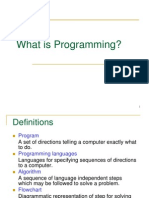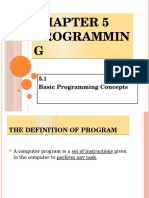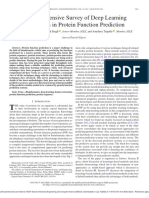Chapter 13 Database Development Process - Database Design
Uploaded by
MikeChapter 13 Database Development Process - Database Design
Uploaded by
Mike7/5/2016
Chapter13DatabaseDevelopmentProcess|DatabaseDesign
BC OPEN TEXTBOOKS
Database Design
ADRIENNE WATT
MainBody
Home
13
Table of
Contents
CHAPTER13DATABASEDEVELOPMENTPROCESS
ADRIENNEWATT
Acoreaspectofsoftwareengineeringisthesubdivisionofthedevelopmentprocessintoaseriesofphases,orsteps,eachof
whichfocusesononeaspectofthedevelopment.Thecollectionofthesestepsissometimesreferredtoasadevelopmentlife
cycle.Thesoftwareproductmovesthroughthislifecycle(sometimesrepeatedlyasitisrefinedorredeveloped)untilitis
finallyretiredfromuse.Ideally,eachphaseinthelifecyclecanbecheckedforcorrectnessbeforemovingontothenext
phase.
Letusstartwithanoverviewofthewaterfallmodelsuchasyouwillfindinmostsoftwareengineeringtextbooks.
Source:http://www.oercommons.org/courses/thedatabasedevelopmentlifecycle/view
SDLCWATERFALL
Thewaterfallfigureaboveillustratesageneralwaterfallmodelwhichcouldapplytoanycomputersystemdevelopment.It
showstheprocessasastrictsequenceofstepswheretheoutputofonestepistheinputtothenextandallofonestephasto
becompletedbeforemovingontothenext.
Wecanusethewaterfallprocessasameansofidentifyingthetasksthatarerequired,togetherwiththeinputandoutputfor
https://opentextbc.ca/dbdesign/chapter/chapter13databasedevelopmentprocess/
1/7
7/5/2016
Chapter13DatabaseDevelopmentProcess|DatabaseDesign
eachactivity.Whatisimportantisthescopeoftheactivities,whichcanbesummarisedasfollows:
Establishingrequirementsinvolvesconsultationwith,andagreementamong,stakeholdersastowhattheywantofa
system,expressedasastatementofrequirements.
Analysisstartsbyconsideringthestatementofrequirementsandfinishesbyproducingasystemspecification.The
specificationisaformalrepresentationofwhatasystemshoulddo,expressedintermsthatareindependentofhowit
mayberealized.
Designbeginswithasystemspecificationandproducesdesigndocuments,andprovidesadetaileddescriptionofhowa
systemshouldbeconstructed.
Implementationistheconstructionofacomputersystemaccordingtoagivendesigndocumentandtakingaccountof
theenvironmentinwhichthesystemwillbeoperating(forexamplespecifichardwareorsoftwareavailableforthe
development).Implementationmaybestaged,usuallywithaninitialsystemthancanbevalidatedandtestedbeforea
finalsystemisreleasedforuse.
Testingcomparestheimplementedsystemagainstthedesigndocumentsandrequirementsspecificationandproducesan
acceptancereportor,moreusually,alistoferrorsandbugsthatrequireareviewoftheanalysis,designand
implementationprocessestocorrect(testingisusuallythetaskthatleadstothewaterfallmodeliteratingthroughthelife
cycle).
Maintenanceinvolvesdealingwithchangesintherequirements,ortheimplementationenvironment,bugfixingor
portingofthesystemtonewenvironments(forexamplemigratingasystemfromastandalonePCtoaUNIXworkstation
oranetworkedenvironment).Sincemaintenanceinvolvestheanalysisofthechangesrequired,designofasolution,
implementationandtestingofthatsolutionoverthelifetimeofamaintainedsoftwaresystem,thewaterfalllifecyclewill
berepeatedlyrevisited.
http://cnx.org/content/m28139/latest/
DATABASELIFECYCLE
Wecanusethewaterfallcycleasthebasisforamodelofdatabasedevelopmentwhichincorporatesthreeassumptions:
Wecanseparatethedevelopmentofadatabasethatis,specificationandcreationofaschematodefinedataina
databasefromtheuserprocessesthatmakeuseofthedatabase.
Wecanusethethreeschemaarchitectureasabasisfordistinguishingtheactivitiesassociatedwithaschema.
Wecanrepresenttheconstraintstoenforcethesemanticsofthedataonce,withinadatabase,ratherthanwithinevery
userprocessthatusesthedata.
http://www.oercommons.org/courses/thedatabasedevelopmentlifecycle/view
https://opentextbc.ca/dbdesign/chapter/chapter13databasedevelopmentprocess/
2/7
7/5/2016
Chapter13DatabaseDevelopmentProcess|DatabaseDesign
Source:http://www.oercommons.org/courses/thedatabasedevelopmentlifecycle/view
Usingtheseassumptions,thediagramaboverepresentsamodeloftheactivitiesandtheiroutputsfordatabasedevelopment.
ItisapplicabletoanyclassofDBMS(databasemanagementsystem),notjustarelationalapproach.
http://cnx.org/content/m28139/latest/
DatabaseApplicationDevelopmentistheprocessofobtainingrealworldrequirements,analyzingrequirements,designing
thedataandfunctionsofthesystemandthenimplementingtheoperationsinthesystem.
http://www.oercommons.org/courses/thedatabasedevelopmentlifecycle/view
REQUIREMENTSGATHERING
ThefirststepisRequirementsGathering.Duringthisstep,thedatabasedesignershavetointerviewthecustomers(database
users)tounderstandtheproposedsystem,obtainanddocumentthedataandfunctionalrequirements.Theresultofthisstepis
adocumentincludingthedetailrequirementsprovidedbytheusers.
Establishingrequirementsinvolvesconsultationwith,andagreementamong,alltheusersastowhatpersistentdatatheywant
tostorealongwithanagreementastothemeaningandinterpretationofthedataelements.Thedataadministratorplaysakey
roleinthisprocessastheyoverviewthebusiness,legalandethicalissueswithintheorganizationthatimpactonthedata
requirements.
Thedatarequirementsdocumentisusedtoconfirmtheunderstandingofrequirementswithusers.Tomakesurethatitis
easilyunderstood,itshouldnotbeoverlyformalorhighlyencoded.Thedocumentshouldgiveaconcisesummaryofall
usersrequirementsnotjustacollectionofindividualsrequirementsastheintentionistodevelopasingleshared
database.
Therequirementsshouldnotdescribehowthedataistobeprocessed,butratherwhatthedataitemsare,whatattributesthey
have,whatconstraintsapplyandtherelationshipsthatholdbetweenthedataitems.
ANALYSIS
Dataanalysisbeginswiththestatementofdatarequirementsandthenproducesaconceptualdatamodel.Theaimof
analysisistoobtainadetaileddescriptionofthedatathatwillsuituserrequirementssothatbothhighandlowlevel
propertiesofdataandtheirusearedealtwith.Theseincludepropertiessuchasthepossiblerangeofvaluesthatcanbe
permittedforattributessuchas,intheSchoolDatabaseexampleforinstance,theStudentcoursecode,coursetitleandcredit
points.
https://opentextbc.ca/dbdesign/chapter/chapter13databasedevelopmentprocess/
3/7
7/5/2016
Chapter13DatabaseDevelopmentProcess|DatabaseDesign
Theconceptualdatamodelprovidesashared,formalrepresentationofwhatisbeingcommunicatedbetweenclientsand
developersduringdatabasedevelopmentitisfocusedonthedatainadatabase,irrespectiveoftheeventualuseofthatdata
inuserprocessesorimplementationofthedatainspecificcomputerenvironments.Therefore,aconceptualdatamodelis
concernedwiththemeaningandstructureofdata,butnotwiththedetailsaffectinghowtheyareimplemented.
Theconceptualdatamodelthenisaformalrepresentationofwhatdataadatabaseshouldcontainandtheconstraintsthedata
mustsatisfy.Thisshouldbeexpressedintermsthatareindependentofhowthemodelmaybeimplemented.Asaresult,
analysisfocusesonWhatisrequired?notHowisitachieved?
http://www.oercommons.org/courses/thedatabasedevelopmentlifecycle/view
LOGICALDESIGN
Databasedesignstartswithaconceptualdatamodelandproducesaspecificationofalogicalschemathiswilldeterminethe
specifictypeofdatabasesystem(network,relational,objectoriented)thatisrequired.Therelationalrepresentationisstill
independentofanyspecificDBMS,itisanotherconceptualdatamodel.
Wecanusearelationalrepresentationoftheconceptualdatamodelasinputtothelogicaldesignprocess.Theoutputofthis
stageisadetailedrelationalspecification,thelogicalschema,ofallthetablesandconstraintsneededtosatisfythe
descriptionofthedataintheconceptualdatamodel.Itisduringthisdesignactivitythatchoicesaremadeastowhichtables
aremostappropriateforrepresentingthedatainadatabase.Thesechoicesmusttakeintoaccountvariousdesigncriteria
including,forexample,flexibilityforchange,controlofduplicationandhowbesttorepresenttheconstraints.Itisthetables
definedbythelogicalschemathatdeterminewhatdataarestoredandhowtheymaybemanipulatedinthedatabase.
DatabasedesignersfamiliarwithrelationaldatabasesandSQLmightbetemptedtogodirectlytoimplementationafterthey
haveproducedaconceptualdatamodel.However,suchadirecttransformationoftherelationalrepresentationtoSQLtables
doesnotnecessarilyresultinadatabasethathasallthedesirableproperties:completeness,integrity,flexibility,efficiency
andusability.Agoodconceptualdatamodelisanessentialfirststeptowardsadatabasewiththeseproperties,butthatdoes
notmeanthatthedirecttransformationtoSQLtablesautomaticallyproducesagooddatabase.Thisfirststepwillaccurately
representthetablesandconstraintsneededtosatisfytheconceptualdatamodeldescription,andsosatisfiesthecompleteness
andintegrityrequirements,butitmaybeinflexibleorofferpoorusability.Thefirstdesignisthenflexedtoimprovethe
qualityofthedatabasedesign.Flexingisatermthatisintendedtocapturethesimultaneousideasofbendingsomethingfora
differentpurposeandweakeningaspectsofitasitisbent.
Thefigurebelowsummarizestheiterative(repeated)stepsinvolvedindatabasedesign,basedontheoverviewgiven.Its
mainpurposeistodistinguishthegeneralissueofwhattablesshouldbeusedfromthedetaileddefinitionoftheconstituent
partsofeachtablethesetablesareconsideredoneatatime,althoughtheyarenotindependentofeachother.Eachiteration
thatinvolvesarevisionofthetableswouldleadtoanewdesigncollectivelytheyareusuallyreferredtoassecondcut
designs,eveniftheprocessiteratesformorethanasingleloop.
http://www.oercommons.org/courses/thedatabasedevelopmentlifecycle/view
https://opentextbc.ca/dbdesign/chapter/chapter13databasedevelopmentprocess/
4/7
7/5/2016
Chapter13DatabaseDevelopmentProcess|DatabaseDesign
Source:http://www.oercommons.org/courses/thedatabasedevelopmentlifecycle/view
First,foragivenconceptualdatamodelitisnotnecessarythatalltheuserrequirementsitrepresentshavetobesatisfiedbya
singledatabase.Therecanbevariousreasonsforthedevelopmentofmorethanonedatabase,suchastheneedfor
independentoperationindifferentlocationsordepartmentalcontrolovertheirdata.However,ifthecollectionofdatabases
containsduplicateddataandusersneedtoaccessdatainmorethanonedatabase,thentherearepossiblereasonsthattheone
databasecansatisfymultiplerequirementsorissuesrelatedtodatareplicationanddistributionneedtobeexamined.
Second,oneoftheassumptionsaboutdatabasedevelopmentisthatwecanseparatethedevelopmentofadatabasefromthe
developmentofuserprocessesthatmakeuseofit.Thisisbasedontheexpectationthat,onceadatabasehasbeen
implemented,alldatarequiredbycurrentlyidentifieduserprocesseshavebeendefinedandcanbeaccessedbutwealso
requireflexibilitytoallowustomeetfuturerequirementschanges.Indevelopingadatabaseforsomeapplicationsitmaybe
possibletopredictthecommonrequeststhatwillbepresentedtothedatabaseandsowecanoptimizeourdesignforthemost
commonrequests.
Third,atadetailedlevel,manyaspectsofdatabasedesignandimplementationdependontheparticularDBMSbeingused.If
thechoiceofDBMSisfixedormadepriortothedesigntask,thatchoicecanbeusedtodeterminedesigncriteriaratherthan
waitinguntilimplementation.Thatis,itispossibletoincorporatedesigndecisionsforaspecificDBMSratherthanproducea
genericdesignandthentailorittotheDBMSduringimplementation.
Itisnotuncommontofindthatasingledesigncannotsimultaneouslysatisfyallthepropertiesofagooddatabase.Soitis
importantthatthedesignerhasprioritizedtheseproperties(usuallyusinginformationfromtherequirementsspecification),
forexample,todecideifintegrityismoreimportantthanefficiencyandwhetherusabilityismoreimportantthanflexibility
inagivendevelopment.
AttheendofourdesignstagethelogicalschemawillbespecifiedbySQLdatadefinitionlanguage(DDL)statements,which
describethedatabasethatneedstobeimplementedtomeettheuserrequirements.
http://www.oercommons.org/courses/thedatabasedevelopmentlifecycle/view
IMPLEMENTATION
Implementationinvolvestheconstructionofadatabaseaccordingtothespecificationofalogicalschema.Thiswillinclude
thespecificationofanappropriatestorageschema,securityenforcement,externalschema,andsoon.Implementationis
heavilyinfluencedbythechoiceofavailableDBMS,databasetoolsandoperatingenvironment.Thereareadditionaltasks
beyondsimplycreatingadatabaseschemaandimplementingtheconstraintsdatamustbeenteredintothetables,issues
relatingtotheusersanduserprocessesneedtobeaddressedandthemanagementactivitiesassociatedwithwideraspectsof
corporatedatamanagementneedtobesupported.InkeepingwiththeDBMSapproachwewantasmanyoftheseconcernsas
possibletobeaddressedwithintheDBMS.Welookatsomeoftheseconcernsbrieflynow.
https://opentextbc.ca/dbdesign/chapter/chapter13databasedevelopmentprocess/
5/7
7/5/2016
Chapter13DatabaseDevelopmentProcess|DatabaseDesign
Inpractice,implementationofthelogicalschemainagivenDBMSrequiresaverydetailedknowledgeofthespecific
featuresandfacilitiesthattheDBMShastooffer.Inanidealworld,andinkeepingwithgoodsoftwareengineeringpractice,
thefirststageofimplementationwouldinvolvematchingthedesignrequirementswiththebestavailableimplementingtools
andthenusingthosetoolsfortheimplementation.Indatabaseterms,thismightinvolvechoosingvendorproductswhos
DBMSandSQLvariantsaremostsuitedtothedatabaseweneedtoimplement.However,wedontliveinanidealworldand
moreoftenthannot,hardwarechoiceanddecisionsregardingtheDBMSwillhavebeenmadewellinadvanceof
considerationofthedatabasedesign.Consequently,implementationcaninvolveadditionalflexingofthedesigntoovercome
anysoftwareorhardwarelimitations.
REALISINGTHEDESIGN
AftertheLogicalDesignhasbeencreated,weneedourdatabasetobecreatedaccordingtothedefinitionswehaveproduced.
ForanimplementationwitharelationalDBMS,thiswillprobablyinvolvetheuseofSQLtocreatetablesandconstraintsthat
satisfythelogicalschemadescriptionandthechoiceofappropriatestorageschema(iftheDBMSpermitsthatlevelof
control).
OnewaytoachievethisistowritetheappropriateSQLDDLstatementsintoafilethatcanbeexecutedbyaDBMSsothat
thereisanindependentrecord,atextfile,oftheSQLstatementsdefiningthedatabase.Anothermethodistowork
interactivelyusingadatabasetoollikeSQLServerManagementStudioorMicrosoftAccess.Whatevermechanismisused
toimplementthelogicalschema,theresultisthatadatabase,withtablesandconstraints,isdefinedbutwillcontainnodata
fortheuserprocesses.
POPULATINGTHEDATABASE
Afteradatabasehasbeencreated,therearetwowaysofpopulatingthetableseitherfromexistingdata,orthroughtheuse
oftheuserapplicationsdevelopedforthedatabase.
Forsometables,theremaybeexistingdatafromanotherdatabaseordatafiles.Forexample,inestablishingadatabasefora
hospitalyouwouldexpectthattherearealreadysomerecordsofallthestaffthathavetobeincludedinthedatabase.Data
mightalsobeboughtinfromanoutsideagency(addresslistsarefrequentlybroughtinfromexternalcompanies)orproduced
duringalargedataentrytask(convertinghardcopymanualrecordsintocomputerfilescanbedonebyadataentryagency).
Insuchsituationsthesimplestapproachtopopulatethedatabaseistousetheimportandexportfacilitiesfoundinthe
DBMS.
Facilitiestoimportandexportdatainvariousstandardformatsareusuallyavailable(thesefunctionsarealsoknowninsome
systemsasloadingandunloadingdata).Importingenablesafileofdatatobecopieddirectlyintoatable.Whendataareheld
inafileformatthatisnotappropriateforusingtheimportfunctionthenitisnecessarytoprepareanapplicationprogramthat
readsintheolddata,transformsthemasnecessaryandtheninsertsthemintothedatabaseusingSQLcodespecifically
producedforthatpurpose.Thetransferoflargequantitiesofexistingdataintoadatabaseisreferredtoasabulkload.Bulk
loadingofdatamayinvolveverylargequantitiesofdatabeingloaded,onetableatatimesoyoumayfindthatthereare
DBMSfacilitiestopostponeconstraintcheckinguntiltheendofthebulkloading.
http://www.oercommons.org/courses/thedatabasedevelopmentlifecycle/view
GUIDELINESFORDEVELOPINGANERDIAGRAM
NOTE:Thesearegeneralguidelineswhichwillassistindevelopingastrongbasisfortheactualdatabasedesign(thelogical
model)
https://opentextbc.ca/dbdesign/chapter/chapter13databasedevelopmentprocess/
6/7
7/5/2016
Chapter13DatabaseDevelopmentProcess|DatabaseDesign
1.Documentallentitiesdiscoveredduringtheinformationgatheringstage.
2.Documentallattributesthatbelongtoeachentity.Selectcandidateandprimarykeys.Ensurethatallnonkeyattributesfor
eachentityarefullfunctionallydependentontheprimarykey.
3.DevelopaninitialERdiagramandreviewwithappropriatepersonnel.(Rememberthatthisisaniterativeprocess).
4.Createnewentities(tables)formultivaluedattributesandrepeatinggroups.Incorporatethesenewentities(tables)inthe
ERdiagram.Reviewwithappropriatepersonnel.
5.VerifyERmodelingbynormalizingtables.
Thiswork,unlessotherwiseexpresslystated,islicensedunderaCreativeCommonsAttribution2.5CanadaLicense.
This textbook is available for free at open.bccampus.ca
https://opentextbc.ca/dbdesign/chapter/chapter13databasedevelopmentprocess/
7/7
You might also like
- Chem 113E Chemistry For Engineers: Loveille Jun Gonzaga 1 Sem AY 2020-2021No ratings yetChem 113E Chemistry For Engineers: Loveille Jun Gonzaga 1 Sem AY 2020-202116 pages
- Assignment 1 Front Sheet: Qualification BTEC Level 5 HND Diploma in ComputingNo ratings yetAssignment 1 Front Sheet: Qualification BTEC Level 5 HND Diploma in Computing23 pages
- Computer Form 2 Schemes of Work - Term 1No ratings yetComputer Form 2 Schemes of Work - Term 116 pages
- Example of Industrial Applications - Heterogeneous Catalysis - W3No ratings yetExample of Industrial Applications - Heterogeneous Catalysis - W319 pages
- Running Head: Quantum Computing: Gateway Technology To The Future 1No ratings yetRunning Head: Quantum Computing: Gateway Technology To The Future 122 pages
- Chemistry For Engineers ElectrochemistryNo ratings yetChemistry For Engineers Electrochemistry7 pages
- Chapter 02 Past Paper and Excercise QuestionsNo ratings yetChapter 02 Past Paper and Excercise Questions10 pages
- Chapter 1. Introduction To Computers and Programming: For Educational Purpose Only Not Be Circulated Without This BannerNo ratings yetChapter 1. Introduction To Computers and Programming: For Educational Purpose Only Not Be Circulated Without This Banner23 pages
- ECE 445 Biomedical Instrumentation Welcome: Dr. Wen Li 1216 Engineering BuildingNo ratings yetECE 445 Biomedical Instrumentation Welcome: Dr. Wen Li 1216 Engineering Building11 pages
- Computer Organization and Assembly Language: Lecture 1 & 2 Introduction and BasicsNo ratings yetComputer Organization and Assembly Language: Lecture 1 & 2 Introduction and Basics33 pages
- Non Ferrous-Metal - Group-2 - Written-Report - ME3No ratings yetNon Ferrous-Metal - Group-2 - Written-Report - ME311 pages
- Engineering: Kidzsearch Safe Wikipedia For KidsNo ratings yetEngineering: Kidzsearch Safe Wikipedia For Kids4 pages
- Conceptual Questions On Acids Bases and Salts Form 3No ratings yetConceptual Questions On Acids Bases and Salts Form 36 pages
- Group Assignment - Sampling DistributionNo ratings yetGroup Assignment - Sampling Distribution3 pages
- Applications of High Performance Liquid Chromatography (HPLC) in To Inorganic and Organometallic CompoundsNo ratings yetApplications of High Performance Liquid Chromatography (HPLC) in To Inorganic and Organometallic Compounds16 pages
- Computer Laboratory Manual (Ai) Version 1.3No ratings yetComputer Laboratory Manual (Ai) Version 1.370 pages
- DATABASE NOTES Database Life Cycle StagesNo ratings yetDATABASE NOTES Database Life Cycle Stages4 pages
- Arcgis Enterprise Functionality Matrix ManualNo ratings yetArcgis Enterprise Functionality Matrix Manual14 pages
- Orenga-Roglá y Chalmeta - 2019 - Framework For Implementing A Big Data Ecosystem in PDFNo ratings yetOrenga-Roglá y Chalmeta - 2019 - Framework For Implementing A Big Data Ecosystem in PDF9 pages
- EMR Name - Model. Cerner PowerChart Ambulatory (PowerWorks ASP) PDFNo ratings yetEMR Name - Model. Cerner PowerChart Ambulatory (PowerWorks ASP) PDF9 pages
- Big Data Documentation - Big Data DocumentationNo ratings yetBig Data Documentation - Big Data Documentation2 pages
- A Comprehensive Survey of Deep Learning Techniques in Protein Function PredictionNo ratings yetA Comprehensive Survey of Deep Learning Techniques in Protein Function Prediction11 pages
- Indexing: Database System Concepts, 6 EdNo ratings yetIndexing: Database System Concepts, 6 Ed15 pages
- Question: Anglo American Cataloguing Rules (AACR) Concentrates On Three Basic Elements of50% (2)Question: Anglo American Cataloguing Rules (AACR) Concentrates On Three Basic Elements of5 pages
- A Brief Survey On Data Mining For Biological and Environmental Problems.No ratings yetA Brief Survey On Data Mining For Biological and Environmental Problems.46 pages
- MongoDB Atlas Best Practices White Paper PDFNo ratings yetMongoDB Atlas Best Practices White Paper PDF21 pages

























































































